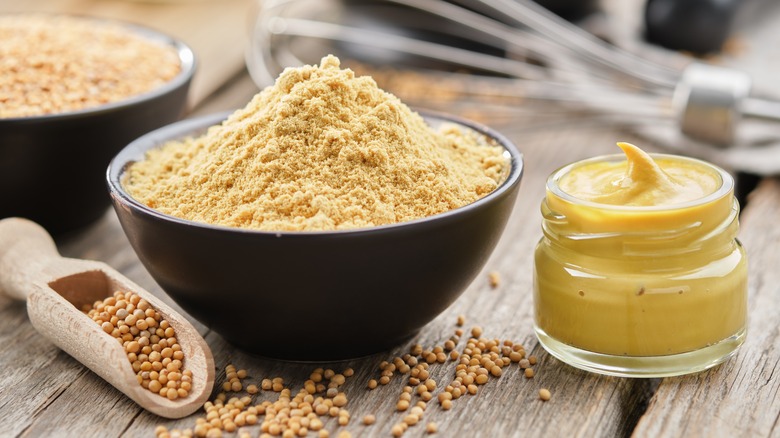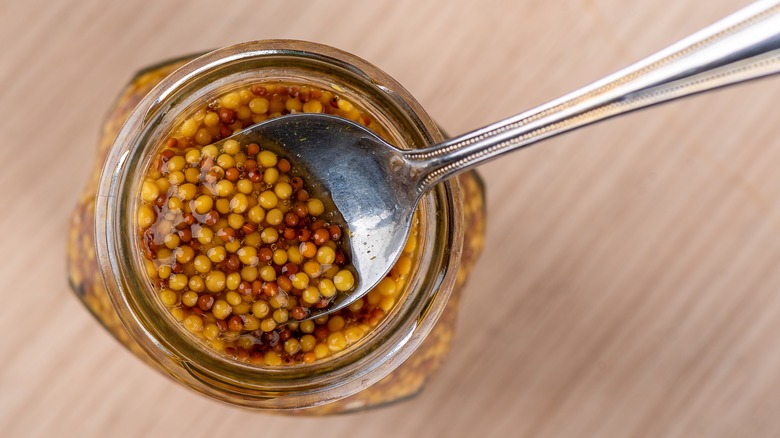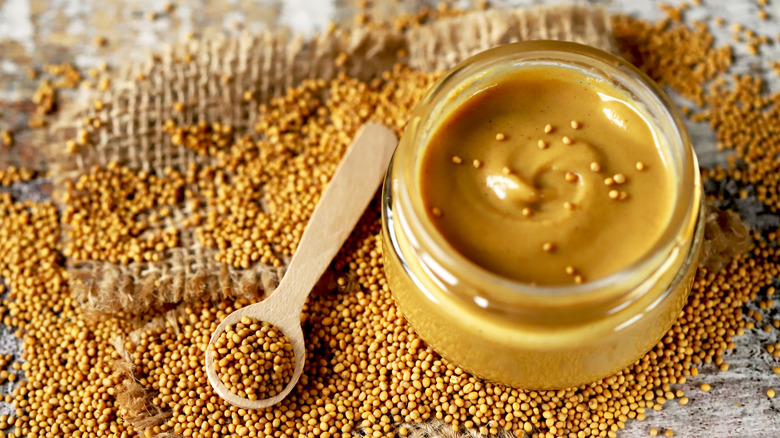Storing Mustard In The Pantry Is A Flavor Mistake. Here's What To Do Instead
Mustard, that bright yellow condiment that defines Chicago-style hot dogs and classic French vinaigrettes. Whenever you're looking for a bottle or jar of mustard, there's nothing else that works as a substitute, but that doesn't mean you use it every day. This can lead to long-forgotten bottles and jars stacking up in storage, and why it's important to know how to store your mustard properly.
Mustard (in whichever form you prefer) is a condiment that is made with the seeds of the mustard plant. These fiery seeds have been in use for almost five millennia, and are one of the few foods mentioned in the bible. As a condiment, mustard takes many forms. Mustard seeds, ground mustard powder, and mustard spreads are made by mixing either of the previous forms with components like herbs, vinegar, wine, or starches. Because of this, mustard has a lot of versatility, and can easily be made at home. It also means that the best way to store mustard is dependent on the type that you use.
How to properly store your mustard
Whether you prefer dijon, yellow, or whole grain mustards, the best way to keep them fresh is to store them in the refrigerator. Refrigeration keeps foods at a temperature where bacteria are less likely to prosper, so it helps them to last longer than if they're stored in the pantry.
Some mustards don't technically need to be refrigerated, but their flavor will last longer when they are. Many mustards are prepared with a vinegar solution as their base. The high acidity of this mix fights off bacterial growth in the same way many pickles do. If your mustards are unopened this can help them last for a year or two in the pantry. Once they're opened and exposed to air though — even if they're highly acidic and safe from bacteria — their flavor will start to deteriorate over time.
If you keep an opened jar of mustard in the pantry for a month, its flavor will start to noticeably fade, while in the refrigerator it can last for up to a year depending on the variety.
Dry mustard powder and mustard seeds also prove to be the exceptions to this rule. Because they are dry seasonings they can be kept in the pantry for six months to a year without losing much of their flavor. Unless you're someone who's eating mustard frequently it's best to buy it in smaller containers to keep from wasting it.
How to tell when mustard has gone bad
While there are some mustards that don't technically spoil thanks to their higher acidity, that doesn't mean that some of them can't go bad. You'll recognize this dilemma If you've ever found a lost jar or bottle in the back of your refrigerator from a time long forgotten.
The first thing to check is the best-by date. Unless you managed to keep the mustard unopened for a long period of time, then the best-by date is a good measure of any open container. If you find a forgotten bottle of mustard and you're well past the best-by date, it's likely not good to eat anymore.
An easy test is to give your mustard a good sniff. After a long time, that scent will likely have weakened, but it is still safe to consume. If that scent has turned particularly noxious or sour though, it's likely that your mustard has gone bad. If the mustard is also darker than when you bought it, seems to be growing mold, or tastes overly acidic or bitter then it's also likely to have gone bad.
One thing not to worry about is a coating of water on top of the mustard. This is likely just liquid separating due to storage and can be solved with a quick stir.


